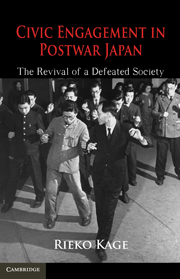Book contents
- Frontmatter
- Contents
- List of Tables
- List of Figures
- Preface
- Acknowledgments
- Civic Engagement in Postwar Japan
- 1 Introduction
- 2 Civic Engagement: The Dependent Variable
- 3 War and Civic Engagement: A Theoretical Framework
- 4 Quantitative Analysis: The Rise of Civic Engagement across Forty-Six Japanese Prefectures
- 5 The Long-Term Effects of Wartime Mobilization: Cross-National Analysis
- 6 Repression and Revival of the YMCA Japan
- 7 Wartime Endorsement and Postwar Repression of a Traditional Art
- 8 Civil Society and Reconstruction in Postwar Japan
- 9 Conclusions
- References
- Index
8 - Civil Society and Reconstruction in Postwar Japan
Published online by Cambridge University Press: 06 December 2010
- Frontmatter
- Contents
- List of Tables
- List of Figures
- Preface
- Acknowledgments
- Civic Engagement in Postwar Japan
- 1 Introduction
- 2 Civic Engagement: The Dependent Variable
- 3 War and Civic Engagement: A Theoretical Framework
- 4 Quantitative Analysis: The Rise of Civic Engagement across Forty-Six Japanese Prefectures
- 5 The Long-Term Effects of Wartime Mobilization: Cross-National Analysis
- 6 Repression and Revival of the YMCA Japan
- 7 Wartime Endorsement and Postwar Repression of a Traditional Art
- 8 Civil Society and Reconstruction in Postwar Japan
- 9 Conclusions
- References
- Index
Summary
OVERVIEW
Until now, this book has focused on highlighting the factors that shape civic engagement in the wake of wars, both within and across countries. This chapter addresses the “so what?” question. Civic engagement grew rapidly in the wake of World War II in Japan, but what were some of the macro-level consequences of this growth? Existing studies of civil society suggest that a growing civic life in Japan should have had important beneficial effects for postwar Japanese reconstruction. How well is this claim substantiated by the empirical evidence? To address this question, this chapter assesses the relationship between Japan's civil society in the immediate postwar period, on the one hand, and postwar reconstruction, on the other.
A voluminous political science literature now examines the factors that determine the success or failure of peace-building, both for civil and for international wars (e.g., Doyle and Sambanis 2006; Fortna 2004; Hartzell et al. 2001; Humphreys and Weinstein 2007; Paris 2004; Werner 1999), but the majority of studies of postwar reconstruction per se consist of in-depth qualitative inquiries of single cases that have been conducted by historians and/or historical sociologists. This work is valuable in its own right, but there is a need for political scientists to build and test a systematic, middle-range theory of the determinants of successful postwar reconstruction.
This chapter argues that civil society serves as a key variable in facilitating the society-wide coordination that makes reconstruction work.
- Type
- Chapter
- Information
- Civic Engagement in Postwar JapanThe Revival of a Defeated Society, pp. 140 - 160Publisher: Cambridge University PressPrint publication year: 2010

